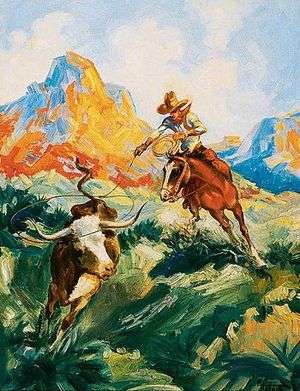Fred Harman
| Fred Harman | |
|---|---|
 Garbed as Red Ryder, Fred Harman appeared at this 1953 event with 13-year-old Samuel Trujillo, Harman's model for Little Beaver. | |
| Born |
February 9, 1902 St. Joseph, Missouri |
| Died |
January 2, 1982 (aged 79) Phoenix, Arizona |
| Nationality | American |
| Area(s) | Cartoonist |
Notable works |
Bronc Peeler Red Ryder |
Fred Harman (February 9, 1902 - January 2, 1982) was an American artist, best known for his popular Red Ryder comic strip, which he drew for 25 years, reaching 40 million readers through 750 newspapers. Harman sometimes used the pseudonym Ted Horn.
Harman was two months old when his parents moved from St. Joseph, Missouri, to Pagosa Springs, Colorado, where he grew up familiar with horses and the ranching lifestyle. His father had previously homesteaded in Pagosa in 1891. Harman dropped out of school after seven years and never had any formal art training.
Kansas City
Born Leslie Fred Harman, he worked as a pressman’s helper at The Kansas City Star, he came in contact with the newspaper's art staff. When he was 20 years old, he was employed at the Kansas City Film Ad Company, working with Walt Disney as an animator. Harman and Disney partnered to form their own company but went broke within a year. Harman then went back to Colorado. Harman's brother, Hugh Harman, was also an animator at Disney's Kansas City studio.[1]
In the fall of 1924, Harman got a wire from an artist friend, Sam McConnell, about an illustrating job at Artcrafts Engraving Company. He took the first train he could get to St. Joseph, home of the Pony Express. In addition to his work as a catalog illustrator for Artcrafts (for the Olathe Boot Company, among other catalogs), Harmon created promotional art, book illustrations and film costume designs commemorating the Pony Express, and bought canvas and paint to create his own paintings at home in his spare time. Artcrafts then was on the 5th floor of the Jenkins Music Building, and Fred met and married musician Lola Andrews, who worked on the first floor of the same building. The couple had a son on May 27, 1927, the day Lindbergh arrived in Paris. Harman did not have the money to pay the hospital bill for his son's birth, so his boss at Artcrafts, William Henry Guenther Sr., bought one of Harman's paintings (of a cowboy with red hair) for the exact amount needed to cover the bill. The couple later moved to St. Paul, Minnesota, where Fred was a partner in an advertising agency for several years before it failed. He was employed in Iowa for a short time before moving his wife and son to Pagosa Springs, where they built a log cabin. In 1933, he moved to Los Angeles, where he edited, illustrated and published a Western magazine that collapsed after three issues. Although the Stendahl Art Gallery staged a show of his paintings, none sold.[1][2]
Red Ryder
Harman self-syndicated his Bronc Peeler strip from 1934 to 1938, finding few takers as he visited various West Coast newspaper offices. When he moved to New York in 1938, he met merchandising entrepreneur Stephen Slesinger and finally found success. He worked with Slesinger to develop Bronc Peeler into Red Ryder, which Slesinger sold to the Newspaper Enterprise Association. It was launched as a Sunday strip November 1938 with the daily strip following four months later. Promoting Red Ryder as "America's famous fighting cowboy", Slesinger began an intensive campaign of merchandising and licensing with a parade of comic books, Big Little Books, novels, a serial films series, radio programs, commercial products, and apparel.[1]
In March 1953, Harman embarked on a six-week USO tour, doing chalk talks at camps in England, France, Germany, Italy, Turkey and Africa.[3]
Cowboy Artists of America

Harman lived in Albuquerque, New Mexico, while also maintaining his Pagosa Springs ranch. After he retired from the strip in 1964, he turned to painting at his Albuquerque studio. The strip was continued by his former assistant, Bob MacLeod, along with Jim Gary, John Wade Hampton and Edmond Good.[1]
Harman was one of the original 1965 members of the Cowboy Artists of America, along with Joe Beeler, Charlie Dye, John Hampton, and George Phippen; and Harman's paintings were included in the first annual exhibition of the Cowboy Artists of America on September 9, 1966, at the National Cowboy Hall of Fame in Oklahoma City.
Harman died in Phoenix, Arizona, in 1982.
Awards
Among other honors, Harman was one of only 75 white men in history to be adopted into the Navajo Nation.[4] In 1958, he received the Sertoma Award as Colorado's Outstanding Citizen.[5]
The Red Ryder Round-up is an annual July 4 weekend event in Pagosa Springs, home of the Fred Harman Art Museum.[6]
References
- 1 2 3 4 Reynolds, Moira Davison. Comic Strip Artists in American Newspapers, 1945-1980, McFarland, 2003.
- ↑ Taos and Santa Fe Painters
- ↑ Western Treasures
- ↑ Colorado Travel and Recreation Guide
- ↑ National Cartoonists Society: Fred Harman
- ↑ Pagosa Daily Post: "Business Spotlight: Fred Harman Art Museum", Pagosa Daily Post, May 1, 2009.